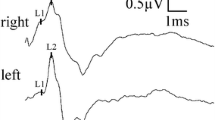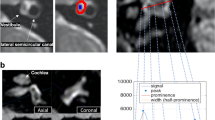Abstract
Twenty-four hours after intratympanic administration of gadolinium contrast material (Gd), the Gd was distributed mainly in the perilymphatic space. Three-dimensional FLAIR can differentiate endolymphatic space from perilymphatic space, but not from surrounding bone. The purpose of this study was to evaluate whether 3D inversion-recovery turbo spin echo (3D-IR TSE) with real reconstruction could separate the signals of perilymphatic space (positive value), endolymphatic space (negative value) and bone (near zero) by setting the inversion time between the null point of Gd-containing perilymph fluid and that of the endolymph fluid without Gd. Thirteen patients with clinically suspected endolymphatic hydrops underwent intratympanic Gd injection and were scanned at 3 T. A 3D FLAIR and 3D-IR TSE with real reconstruction were obtained. In all patients, low signal of endolymphatic space in the labyrinth on 3D FLAIR was observed in the anatomically appropriate position, and it showed negative signal on 3D-IR TSE. The low signal area of surrounding bone on 3D FLAIR showed near zero signal on 3D-IR TSE. Gd-containing perilymphatic space showed high signal on 3D-IR TSE. In conclusion, by optimizing the inversion time, endolymphatic space, perilymphatic space and surrounding bone can be separately visualized on a single image using a 3D-IR TSE with real reconstruction.



Similar content being viewed by others
References
Zou J, Pyykko I, Bjelke B, Dastidar P, Toppila E (2005) Communication between the perilymphatic scalae and spiral ligament visualized by in vivo MRI. Audiol Neurootol 10(3):145–152
Nakashima T, Naganawa S, Sugiura M, Teranishi M, Sone M, Hayashi H, Nakata S, Katayama N, Ishida IM (2007) Visualization of endolymphatic hydrops in patients with Meniere’s disease. Laryngoscope 117(3):415–420
Park HW, Cho MH, Cho ZH (1986) Real-value representation in inversion-recovery NMR imaging by use of a phase-correction method. Magn Reson Med 3(1):15–23
Bandai H, Tsunoda A, Mitsuoka H, Arai H, Sato K, Makita J (2002) Fast inversion recovery magnetic resonance imaging with the real reconstruction method: a diagnostic tool for cerebral gliomas. Neurol Med Chir (Tokyo) 42(1):5–10
Naganawa S, Koshikawa T, Nakamura T, Fukatsu H, Ishigaki T, Aoki I (2003) High-resolution T1-weighted 3D real IR imaging of the temporal bone using triple-dose contrast material. Eur Radiol 13(12):2650–2658
Schuknecht HF, Suzuka Y, Zimmermann C (1990) Delayed endolymphatic hydrops and its relationship to Meniere’s disease. Ann Otol Rhinol Laryngol 99(11):843–853
Fujino K, Naito Y, Endo T, Kanemaru S, Hiraumi H, Tsuji J, Ito J (2007) Clinical characteristics of delayed endolymphatic hydrops: long-term results of hearing and efficacy of hyperbaric oxygenation therapy. Acta Otolaryngol Suppl 1557:22–25
Schwaber MK (2002) Transtympanic gentamicin perfusion for the treatment of Meniere’s disease. Otolaryngol Clin North Am 35(2):287–295
Haynes DS, O’Malley M, Cohen S, Watford K, Labadie RF (2007) Intratympanic dexamethasone for sudden sensorineural hearing loss after failure of systemic therapy. Laryngoscope 117(1):3–15
Ahn JH, Han MW, Kim JH, Chung JW, Yoon TH (2007) Therapeutic effectiveness over time of intratympanic dexamethasone as salvage treatment of sudden deafness. Acta Otolaryngol. 2007 Aug 22; 1-4 [Epub ahead of print] DOI 10.1080/00016480701477602
De Stefano A, Dispenza F, De Donato G, Caruso A, Taibah A, Sanna M (2007) Intratympanic gentamicin: a 1-day protocol treatment for unilateral Meniere’s disease. Am J Otolaryngol 28(5):289–293
Griswold MA, Jakob PM, Heidemann RM, Nittka M, Jellus V, Wang J, Kiefer B, Haase A (2002) Generalized autocalibrating partially parallel acquisitions (GRAPPA). Magn Reson Med 47(6):1202–1210
Salt AN, Henson MM, Gewalt SL, Keating AW, DeMott JE, Henson OW, Jr (1995) Detection and quantification of endolymphatic hydrops in the guinea pig cochlea by magnetic resonance microscopy. Hear Res 88(1-2):79–86
Shinomori Y, Spack DS, Jones DD, Kimura RS (2001) Volumetric and dimensional analysis of the guinea pig inner ear. Ann Otol Rhinol Laryngol 110(1):91–98
Buckingham RA, Valvassori GE (2001) Inner ear fluid volumes and the resolving power of magnetic resonance imaging: can it differentiate endolymphatic structures? Ann Otol Rhinol Laryngol 110(2):113–117
Niyazov DM, Andrews JC, Strelioff D, Sinha S, Lufkin R (2001) Diagnosis of endolymphatic hydrops in vivo with magnetic resonance imaging. Otol Neurotol 22(6):813–817
Koizuka I, Seo Y, Murakami M, Seo R, Kato I (1997) Micro-magnetic resonance imaging of the inner ear in the guinea pig. NMR Biomed 10(1):31–34
Koizuka I, Seo R, Kubo T, Matsunaga T, Murakami M, Seo Y, Watari H (1995) High-resolution MRI of the human cochlea. Acta Otolaryngol Suppl 520(Pt 2):256–257
Koizuka I, Seo R, Sano M, Matsunaga T, Murakami M, Seo Y, Watari H (1991) High-resolution magnetic resonance imaging of the human temporal bone. ORL J Otorhinolaryngol Relat Spec 53(6):357–361
Ito T, Naganawa S, Fukatsu H, Ishiguchi T, Ishigaki T, Kobayashi M, Kobayashi K, Ichinose N, Miyazaki M, Kassai Y (1999) High-resolution MR images of inner ear internal anatomy using a local gradient coil at 1.5 Tesla: correlation with histological specimen. Radiat Med 17(5):343–347
Naganawa S, Koshikawa T, Fukatsu H, Ishigaki T, Aoki I, Ninomiya A (2002) Fast recovery 3D fast spin-echo MR imaging of the inner ear at 3 T. AJNR Am J Neuroradiol 23(2):299–302
Naganawa S, Komada T, Fukatsu H, Ishigaki T, Takizawa O (2006) Observation of contrast enhancement in the cochlear fluid space of healthy subjects using a 3D-FLAIR sequence at 3 Tesla. Eur Radiol 16(3):733–737
Author information
Authors and Affiliations
Corresponding author
Rights and permissions
About this article
Cite this article
Naganawa, S., Satake, H., Kawamura, M. et al. Separate visualization of endolymphatic space, perilymphatic space and bone by a single pulse sequence; 3D-inversion recovery imaging utilizing real reconstruction after intratympanic Gd-DTPA administration at 3 Tesla. Eur Radiol 18, 920–924 (2008). https://doi.org/10.1007/s00330-008-0854-8
Received:
Revised:
Accepted:
Published:
Issue Date:
DOI: https://doi.org/10.1007/s00330-008-0854-8




